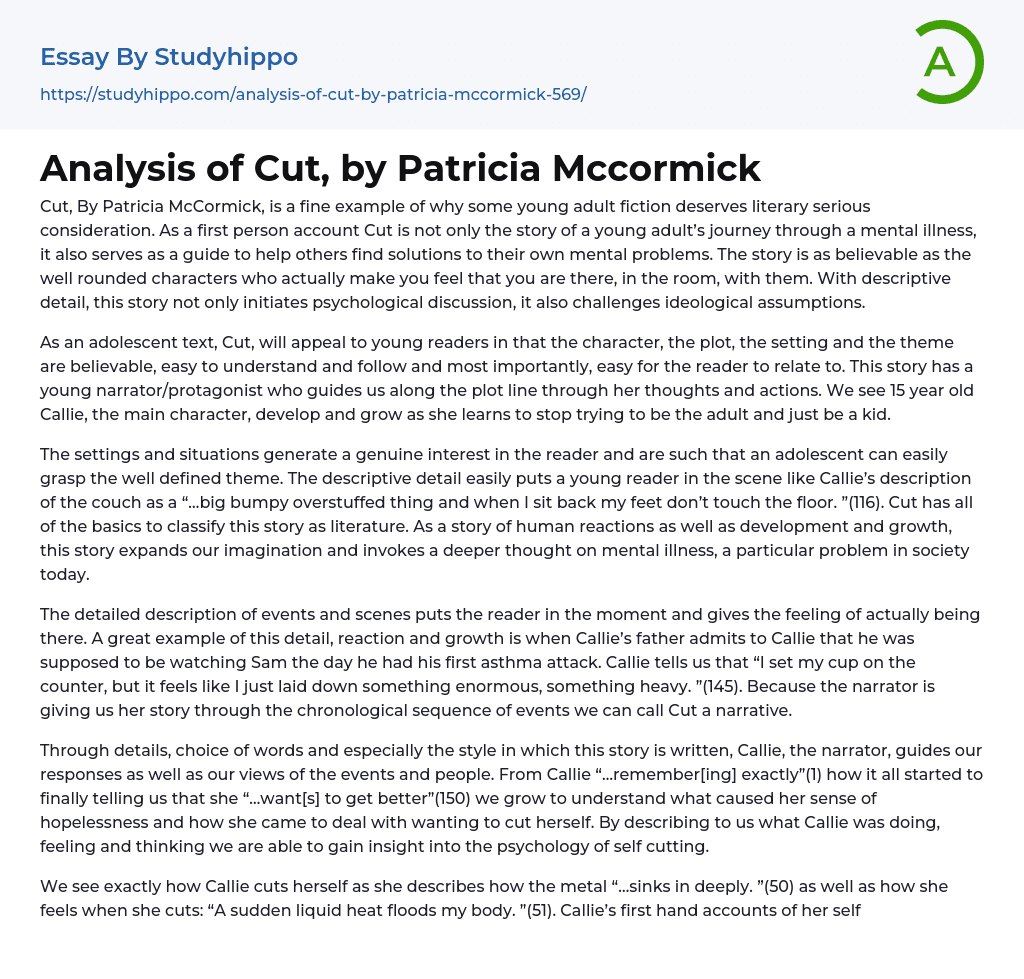Cut, By Patricia McCormick, is a fine example of why some young adult fiction deserves literary serious consideration. As a first person account Cut is not only the story of a young adult’s journey through a mental illness, it also serves as a guide to help others find solutions to their own mental problems. The story is as believable as the well rounded characters who actually make you feel that you are there, in the room, with them. With descriptive detail, this story not only initiates psychological discussion, it also challenges ideological assumptions.
As an adolescent text, Cut, will appeal to young readers in that the character, the plot, the setting and the theme are believable, easy to understand and follow and most importantly, easy for the reader to relate to. This story has a young
...narrator/protagonist who guides us along the plot line through her thoughts and actions. We see 15 year old Callie, the main character, develop and grow as she learns to stop trying to be the adult and just be a kid.
The settings and situations generate a genuine interest in the reader and are such that an adolescent can easily grasp the well defined theme. The descriptive detail easily puts a young reader in the scene like Callie’s description of the couch as a “…big bumpy overstuffed thing and when I sit back my feet don’t touch the floor. ”(116). Cut has all of the basics to classify this story as literature. As a story of human reactions as well as development and growth, this story expands our imagination and invokes a deeper thought on mental illness, a particular problem in societ
today.
The detailed description of events and scenes puts the reader in the moment and gives the feeling of actually being there. A great example of this detail, reaction and growth is when Callie’s father admits to Callie that he was supposed to be watching Sam the day he had his first asthma attack. Callie tells us that “I set my cup on the counter, but it feels like I just laid down something enormous, something heavy. ”(145). Because the narrator is giving us her story through the chronological sequence of events we can call Cut a narrative.
Through details, choice of words and especially the style in which this story is written, Callie, the narrator, guides our responses as well as our views of the events and people. From Callie “…remember[ing] exactly”(1) how it all started to finally telling us that she “…want[s] to get better”(150) we grow to understand what caused her sense of hopelessness and how she came to deal with wanting to cut herself. By describing to us what Callie was doing, feeling and thinking we are able to gain insight into the psychology of self cutting.
We see exactly how Callie cuts herself as she describes how the metal “…sinks in deeply. ”(50) as well as how she feels when she cuts: “A sudden liquid heat floods my body. ”(51). Callie’s first hand accounts of her self cutting is not clouded by the prior experiences, cultural values or beliefs and we are able to see exactly why and how she does it and how it makes her feel. Cut concedes the ideological assumption that children who experience neglect avoid connections and will rely
on themselves to relieve stress.
Callie’s father was rarely around and her mother was so consumed with Sam’s asthma and sickness that Callie was often left with nobody to care for her, tell her that she is not responsible for Sam’s condition, and show her the love and attention that she needed. Because she had nobody for support Callie turned to cutting, not because it caused pain but, because it relieved the pain. By cutting Callie is able to relieve the internal pain and stress without the help or support of others. Cut gives us the inside perspective of what those who harm themselves go through.
Through the first person narrative style that this story is written we not only see but feel what the main character sees and feels. This adolescent literature uses the psychology of self cutting to initiate psychological discussions on the subject of why people turn to self harm to relieve stress and tension. The style in which this story is presented, the serious subject matter it involves and the believable journey that Callie takes to finally open up and seek help are all worthy reasons why young adult fiction deserves literary serious consideration.
- Child essays
- Childcare essays
- Child labor essays
- Doll essays
- Emergence essays
- Anxiety Disorder essays
- Post-traumatic Stress Disorder essays
- Academia essays
- Higher Education essays
- Language Learning essays
- Studying Business essays
- Education System essays
- Study essays
- First Day of School essays
- Scholarship essays
- Pedagogy essays
- Curriculum essays
- Coursework essays
- Studying Abroad essays
- Philosophy of Education essays
- Purpose of Education essays
- Brainstorming essays
- Educational Goals essays
- Importance Of College Education essays
- Brown V Board of Education essays
- The Importance Of Higher Education essays
- Online Education Vs Traditional Education essays
- Academic And Career Goals essays
- Academic Integrity essays
- Brown Vs Board Of Education essays
- Distance learning essays
- Technology in Education essays
- Vocabulary essays
- Writing Experience essays
- Importance of Education essays
- Early Childhood Education essays
- Academic Degree essays
- Academic Dishonesty essays
- School Uniform essays
- Academic writing essays
- Cheating essays
- Bachelor's Degree essays
- MBA essays
- College Life essays
- Grade essays
- Diploma essays
- Phonology essays
- Sentence essays
- Filipino Language essays
- Pragmatics essays




